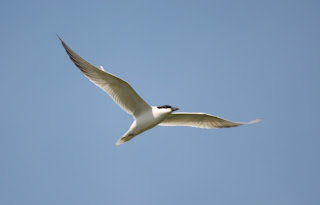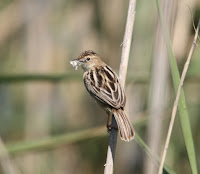I never did get the three days birding of the last week in March written up but as there was (a) nothing particularly outstanding, (b) no nice photos and (c) having sister out from the UK by the time I got round to even thinking about it, all was distant past but this one, when I get round to it after this first bit, will be on line this afteroon.
It's not often that I get queries about birds and less so about calls, but Prof., Chris Feare has written to ask how one can tell the difference between the call of a
Rose-ringed/Ring-necked Parakeet and a
Tornado. Well, Chris, the
Rose-ringed has relatively gentle and certainly less grating squawk in comparison with the
Monk Parakeets that we have down here and is dumb in comparison with a Tornado, which also calls on the wing. The call of the Tornado is a huge, frightening blast of many millions of decibels and will leave one deaf and trembling in a direct, high speed, overhead pass. Chickens will refuse to lay eggs, cows to give no milk and many, both young and old, to have an attack of the vapours and/or throw a major whoopsie (in the case of maiden aunts). I think that sums it all up. You'll know one when you hear it!
Migration is in full swing with first records of many species on a virtually daily basis, including an early
Whinchat near Velez Málaga. I have had disappointingly few migrants in my garden but on 01/04 I happened to be looking out when a
Wryneck dropped in for no more than 45 seconds, definitely a case of pure luck and '
now you see me, now you don't' and a new species for the garden. More intriguingly there have been records of two trans-Atlantic species. The first was a
Song Sparrow in Algeciras, seen and photographed by some Finnish birders but which is almost certainly a case of 'passage-assist', or in simple English, hitching a lift on a boat plying the Atlantic. Such hitching of lifts is well documented. The other species was an
American Wigeon seen during one afternoon at Palmones, near Algeciras, in the company of other migrant ducks including Garganey and which stayed only the one afternoon. That, I believe, was very probably a bird that arrived last autumn, migrated south and is now moving north but many degrees east of where it should be, not, as some think, a recent arrival after the storms which continue in the Atlantic.
So, now to yesterday's trip to Fuente de Piedra and the laguna Dulce at Campillos with Ron Appleby before he returns to the Arctic wastes of North Yorkshire. In fact, we darned nearly didn't get as about 07.30 an Armageddon-like cloud came in from the west and it was belting down over the sea. Fortunately, by the time Ron had got here the cloud had gone on to create havoc elsewhere (note how unselfish I am) and we were off, We were up at Fuente by 0925 to be met by greyish skies which promised little of hope and a cold, and I mean cold, wind which too got worse. However, nevear let it be said that we Yorkshire sèptuagenerians are easily thwarted from birding and we had a jolly good morning. The wind basically precluded seeing much in the passerine line as they were either absent or just keeping under cover (or both). We had a look at the lake behind the information centre (nothing of note) and walked the board walk and path towards La Vicaria and very profitable it was.

There is a lot of water, too much for the
Flamingos to settle down for breeding and I counted at least eight different nuclei. The same applies to the
Gull-billed Terns and we saw only 2 all morning plus another at the laguna Dulce, a numerical disaster at this time of year. Nesting waders are also having it crude, as there is little in the way of accessible margins for nesting and we saw only a pair of
Little Ringed Plovers, relatively low numbers of the Hystericals (a.k.a.
Black.winged Stilts) but reasonable numbers of
Avocets, although few seemed interested in territorial behaviour. It is also a disaster for short-legged waders and there were no stints of any description but on the other hand the long-legged waders are present.

We saw at least 18
Redshanks, 17 of them on one pool the far side of the road to Sierra de Yeguas, there were two flocks of 5
Curlew Sandpipers in each (we know they were different because the plumage composition was different in each). 2
Wood Sandpipers seen from the start of the boardwalk were quickly joined by 5 more which swept in fast and low and gave good views. The
Ruffs also gave good views, there being one stunning male (large top photo) which will be even better once in full breeding plumage. The photo on the left shows the size difference (sexual dimorphism) between the males (the Ruff, on the right) and female (Reeve in older English, on the left).
There was a small selection of ducks but we saw only 2
Gadwall, a few
Mallard,
Shoveler numbers are down considerably and some 10
Shelducks, plus a very attractive pair of
Red-crested Pochards, the male hardly a role model for inconspicuity. It was just after we had commented on the lack of harriers that we saw the first
Marsh Harrier, a very bonny male, and we were to see another male later, as well as a females and 2 young birds. There were few
Yellow Wagtails, only one was a male
flavissima (the British race), the remaining few males all being
iberiae.

As the weather was worsening visibly from the west and rain was on the way, we decided to make a quick sortie to the laguna Dulce and indeed the first drops were falling as we arrived and the wind was whipping up wavelets with many of the water birds distant and not hugely visible. We did see a few
White-headed Ducks and although the few
Great Crested Grebes were feeding we couldn't see what. However, this morning Manolo Rendón, Lord High-Everything-Else of Fuente de Piedra and the other lagoons, rang me to tell that he was watching them eating tritons, otherswise known as newts! A couple of pairs of
Black-necked Grebes were showing well next to the hide, ruby red eyes brightening a dull grey and by then wet morning. There were lots of hirundines around, mainly
Barn Swallows and at least 100
Sand Martins, many of which took turns resting in the tamarisks (above). By which hour it was time for Ron and I to head down for the coast, the rain accompanying us all the way, and he well satisfied with his last birding morning here this winter.
 Of passerines, very little except this female Stonechat (L) who was busy dealing with a very large green caterpillar and which she eventually swallowed with some difficulty - you can see the tail end of it in her gape. Meanwhile, the male, a splendid little chap as male Stonechats tend to be at this time of year, was giving me hell for daring to be on his patch of thistle territory (R). I saw a nice male Red-crested Pochard flight in, where his missus was, I know not but possibly sitting on a clutch of eggs. Plus a beautiful pair but distant pair of handsome Shelducks also flew in but I was slow with the camera.
Of passerines, very little except this female Stonechat (L) who was busy dealing with a very large green caterpillar and which she eventually swallowed with some difficulty - you can see the tail end of it in her gape. Meanwhile, the male, a splendid little chap as male Stonechats tend to be at this time of year, was giving me hell for daring to be on his patch of thistle territory (R). I saw a nice male Red-crested Pochard flight in, where his missus was, I know not but possibly sitting on a clutch of eggs. Plus a beautiful pair but distant pair of handsome Shelducks also flew in but I was slow with the camera.



































